|
|||||
FlyingRC.net is a
Veteran-Owned site.

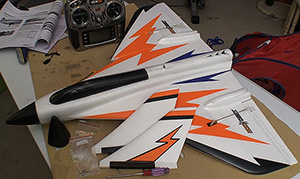 |
This is how the RocHobby High Speed Swift Delta Wing Racer comes out of the box. I had it flight ready in about 10 minutes. Working up the courage to go to full throttle takes about as long. Click image to enlarge |
RocHobby High Speed Swift Delta Wing Racer
Fast, unlimited vertical and thankfully very tough
Text, photos and video by Tom Hintz
Flight video by G Jawhar
Posted - 2-9-2015
One of the trends at our (and many other) flying field is flying small, high-speed foamies in groups. Who has the fastest plane is the obvious goal but only slightly more important than keeping track of your own plane to keep it away from the ground. The sheer speed of these little planes makes tiny control-related mistakes perilous for the plane. The ground is always unforgiving and coming up very fast. The RocHobby High Speed Swift Delta Wing Racer literature/videos claim 90MPH with this model and I see nothing to refute that. The RocHobby High Speed Swift Delta Wing Racer is quick with the 3S battery but I am sure folks are stuffing a 4S pack in the RocHobby High Speed Swift Delta Wing Racer also.
While many of the most popular “speed” planes are versions of WWII warbirds but more and more true speed-designed models are coming to the market that loosely resemble full scale pylon racers. Not wanting to get what everybody else had I looked around and finally came across the RocHobby High Speed Swift Delta Wing Racer from MotionRC.com. This is the high speed version of this model and sports a hotter motor and an ESC with more capacity. Those attributes along with a decent price sealed the deal and I ordered one, with 4 extra props. I had been watching the other guys and noted how often they were looking for a new prop.
The Basics
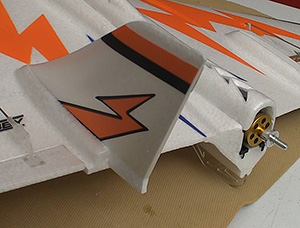 |
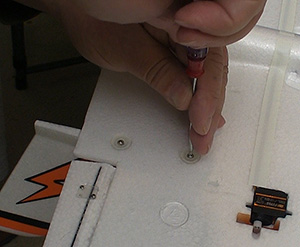 |
The major part of assembly is installing the twin vertical stabilizers. (left) They even include a screw driver (right) for the two screws that secure each vertical stab. The servos and linkage are installed for you and mine were adjusted well. Click images to enlarge |
|
The RocHobby High Speed (HS) Swift Delta Wing Racer I bought (ROC-005-1) came almost ready to fly needing only the installation of the twin vertical stabilizers (they even give you a screw driver) and a receiver you supply. Being a true delta design the RocHobby High Speed Swift Delta Wing Racer uses elevons which means our radio must have that capability. When installing the receiver the instructions list where to plug in the “elevator”, “aileron” and throttle servos with each clearly marked with a tape at the plug. There is only one elevator and one aileron servo because of the elevons configuration. I used a spare Spektrum 6-chanel receiver which fit in the fuselage by the ESC easily.
The wings and fuselage are one piece, molded from EPO foam fitted with molded in carbon rods to boost the structural integrity. An interesting feature is the removable nose cone that is held in place with a magnet. They give you an extra nose cone in the box which should warn you about launching and flying the RocHobby High Speed Swift Delta Wing Racer. They expect you to crash – and you more than likely will.
The RocHobby High Speed Swift Delta Wing Racer has a wingspan of 26.8-inches (675mm) and is 25-inches (630mm) long with a flying weight (no battery) of 13.6oz. (386g). The motor is a 2215-KV3400 and controlled by a stout 50A (Internal SBEC) speed controller equipped with a Deans connector. A pair of 9gram servos are factory installed as is an EDF, 4.5 x 4.5E 2 blade prop.
One of the nice features of the RocHobby High Speed Swift Delta Wing Racer fuselage is the guard located of the bottom just ahead of the pusher prop. This fin/guard keeps the prop off of the ground on landing and should help keep the prop out of your hand during hand launching. Also note that the servos and linkages are all top-mounted to protect them during landings. The RocHobby High Speed Swift Delta Wing Racer has a built-in nose wheel set into the forward portion of the fuse that makes belly landings on grass surprisingly smooth.
Actual assembly literally took 10 minutes. The servos, motor and ESC are factory installed and the elevon linkage was adjusted very well right out of the box. You also need 11.1V 3S 2200mAh LiPo's to power it. The ESC came with a Deans connector which matched my batteries.
At the Field
Concern with any hand-launched pusher style plane is keeping your hand out of the prop. The guard ahead of the prop will certainly help but you have to follow through on the toss to be sure your hand stays out of the prop. Make no mistake, that little prop will cut you up if you let it.
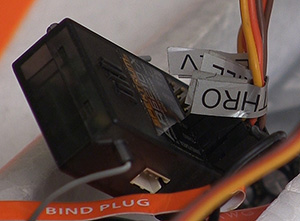 |
 |
The servo plugs (left) are all labeled to make following the instructions on setting up the receiver easy. You do need to have elevon capability in your radio. The motor and prop (right) are factory installed. Click images to enlarge |
|
There is a molded in spot for hand launching the RocHobby High Speed Swift Delta Wing Racer and you have to use that. Some will have another person throw the RocHobby High Speed Swift Delta Wing Racer into the air with the motor off and then nail the throttle to take it up. This plane does glide well so this technique isn’t as problematic as it sounds. Others will keep the throttle around 50% and toss it themselves or have someone toss it at a relatively steep upward angle. Give it too much throttle and the RocHobby High Speed Swift Delta Wing Racer torque rolls left in a big way. 50% throttle is plenty to get the RocHobby High Speed Swift Delta Wing Racer flying.
While trimming the RocHobby High Speed Swift Delta Wing Racer you will find that it needs a bunch of up trim from what looks right siting on the bench. This is a function of being a delta wing and the thrust angle in the motor but it is important to flying at speed as well as during the launch. My RocHobby High Speed Swift Delta Wing Racer wound up with about 3/16” of up trim from what looks neutral. It is good at speed and most flying but you have to hold a bit of down elevator to coax the RocHobby High Speed Swift Delta Wing Racer out of the sky.
Flying the RocHobby High Speed Swift Delta Wing Racer is simple in some ways and not so much in others. If you are a constant user of the rudder as I am, the RocHobby High Speed Swift Delta Wing Racer is going to feel very weird until you realize that you are trying to help the turns with a rudder it does not have. Once you get the no rudder issue through your head the RocHobby High Speed Swift Delta Wing Racer is pretty simple to fly.
The pure speed this plane is capable of, something around 90MPH, means that mistakes grow critical quickly. If you over roll the RocHobby High Speed Swift Delta Wing Racer going into a turn and nail the elevator it swoops down at the ground with impressive speed. Remember that the throttle can be your friend if you pull that back some while you get the feel of the RocHobby High Speed Swift Delta Wing Racer.
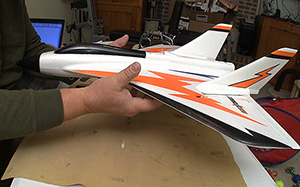 |
The CG is critical on a small delta wing but I was able to get it right on the money just by placing the battery a little forward in its space. Click image to enlarge |
It is also important to remember that you are flying a 27” plane. Combine the physical size with the speed and the RocHobby High Speed Swift Delta Wing Racer can be rushing out of sight before you know it. Here again, lots of turns and reduced throttle will help get you used to handling this plane.
I did stick my RocHobby High Speed Swift Delta Wing Racer into the ground a couple times, once at far more speed than I thought it could survive but it did and still flies fine. Landings can be a little touchy until you learn that some down elevator is probably going to be needed or the RocHobby High Speed Swift Delta Wing Racer will float on by and glide farther than you think possible.
The instructions suggest some dual rate settings and it would be wise to program them in just to have handy in case your flying ego gets out in front of you a tad. I have my typical “all I can get” control throws dialed in and the roll rate at speed is not to be taken lightly. With these throws the RocHobby High Speed Swift Delta Wing Racer can pitch up or down like it ran into something in the sky so I have to be paying attention all of the time and going slower the rest of the time.
Conclusions
The RocHobby High Speed Swift Delta Wing Racer is a fun plane to fly if you enjoy pure speed with “point-it-anywhere” performance on a budget. I bought the RocHobby High Speed Swift Delta Wing Racer from Motion RC (with 4 extra props) or $154.95 (1-28-2015) which included shipping. In the world of RC flying that is short money for a tough plane that promises a lot of fun in the sky.
You have to respect the speed, overall size and nearly invisible profile when flying the RocHobby High Speed Swift Delta Wing Racer but with common sense and some practice you will be throwing this thing all over the sky. I honestly have no idea if there is a ceiling to the RocHobby High Speed Swift Delta Wing Racer flight envelope but I am certain that it won’t take long to get out of sight even straight up. Watch the accompanying video we shot and you will get a better feel for how hard the RocHobby High Speed Swift Delta Wing Racer is to keep anywhere near the cameras viewfinder.
Video Tour |
If you are looking for a fast, economical plane that you don’t need a trailer to get from here to there, check out the RocHobby High Speed Swift Delta Wing Racer. In addition to a decent initial price this is a tough plane that usually handles some major looking crashes with ease. If you exceed its crash worthiness, Motion RC has a full line of replacement parts.
See the RocHobby High Speed Swift Delta Wing Racer on the Motion RC web site – Click Here
Have a comment on this review? –Email Me!
All Flyingrc.net written, photographic and drawn materials are property of and copyright by Tom Hintz and Flyingrc.net 2013-2020 Materials cannot be used in any way without the prior written permission of the owner.
Privacy Statement


